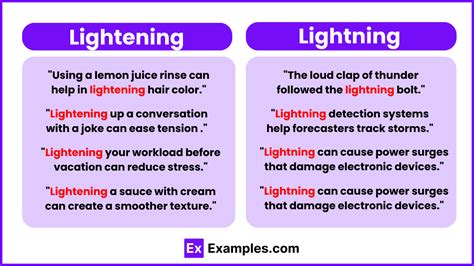The terms "lighting" and "lightning" are often confused with one another due to their similar spellings, but they have vastly different meanings and uses. Understanding the distinction between these two words is essential for effective communication and to avoid misunderstandings in various contexts, including science, technology, and everyday conversation.
Lighting refers to the use of artificial light sources to illuminate an area or object. This can include a wide range of applications, from residential and commercial lighting to theatrical and industrial lighting. The primary purpose of lighting is to provide visibility, ambiance, and sometimes to enhance the aesthetic appeal of a space. The term "lighting" encompasses a broad spectrum of technologies and designs, including incandescent bulbs, LED lights, fluorescent lights, and more, each with its unique characteristics, advantages, and energy efficiency levels.
On the other hand, lightning is a massive electrostatic discharge that occurs during thunderstorms. It is a natural phenomenon characterized by a brilliant flash of light and a thunderous sound, known as thunder. Lightning is a complex process that involves the buildup of electrical charges between cloud and ground or within clouds, culminating in a discharge of electricity. This discharge is incredibly hot and can reach temperatures of up to 50,000 degrees Celsius, which is hotter than the surface of the Sun. Lightning can cause significant damage to structures, start fires, and pose a serious threat to human life and safety.
Key Points
- Lighting refers to the use of artificial light sources for illumination.
- Lightning is a natural electrical discharge that occurs during thunderstorms.
- The two terms differ significantly in their meanings, applications, and implications.
- Understanding the difference between lighting and lightning is crucial for clear communication and safety.
- Both lighting and lightning have significant impacts on human activities and the environment.
Scientific and Technical Aspects

From a scientific perspective, the study of lightning involves understanding the physics of electrical discharges, atmospheric conditions, and the mechanisms that lead to the formation of lightning. Researchers use advanced technologies, including radar, satellite imaging, and ground-based observation systems, to study lightning and its effects on the environment. This knowledge is essential for developing early warning systems, improving lightning protection technologies, and mitigating the risks associated with lightning strikes.
In contrast, the field of lighting is focused on the design, development, and application of artificial lighting solutions. This encompasses a wide range of disciplines, including electrical engineering, architecture, and psychology, as the perception of light and its effects on human behavior and health are critical considerations. Advances in lighting technology have led to more energy-efficient solutions, such as LED lighting, which not only reduce energy consumption but also offer longer lifetimes and improved durability compared to traditional lighting methods.
Environmental Impact
Both lighting and lightning have significant environmental implications. Artificial lighting can contribute to light pollution, which affects nocturnal wildlife, disrupts natural ecosystems, and wastes energy. On the other hand, lightning plays a crucial role in the Earth’s ecosystem, contributing to the nitrogen cycle and influencing the chemical composition of the atmosphere. However, the increasing frequency and intensity of lightning storms, potentially linked to climate change, pose challenges for environmental sustainability and human safety.
| Aspect | Lighting | Lightning |
|---|---|---|
| Purpose | Illumination and ambiance | Natural electrical discharge |
| Causes | Human activity (design and installation) | Atmospheric conditions (thunderstorms) |
| Effects | Visibility, energy consumption, light pollution | Environmental impact, damage to structures, risk to human life |

Conclusion and Future Directions

In conclusion, the difference between lighting and lightning is not merely a matter of spelling but reflects fundamentally different concepts with distinct implications for science, technology, and everyday life. As research and development continue to advance our understanding and application of both lighting and lightning, it is essential to maintain a nuanced perspective that appreciates the complexities and interdependencies of these phenomena. By doing so, we can harness the benefits of artificial lighting while respecting the power and importance of natural lightning in our environment.
What is the primary purpose of lighting in residential settings?
+The primary purpose of lighting in residential settings is to provide visibility, ensuring safety and comfort, while also contributing to the aesthetic appeal of the home.
How does lightning form during a thunderstorm?
+Lightning forms during a thunderstorm when there is a buildup of electrical charges between the cloud and the ground or within the cloud. This buildup eventually leads to a discharge of electricity, known as a lightning strike.
What are some of the environmental impacts of artificial lighting?
+Artificial lighting can contribute to light pollution, which affects nocturnal wildlife and disrupts natural ecosystems. It can also lead to energy waste if not managed efficiently.
Meta Description: Understand the fundamental difference between lighting and lightning, from their definitions and implications to their environmental and technological aspects, and learn how each affects our daily lives and the world around us.



